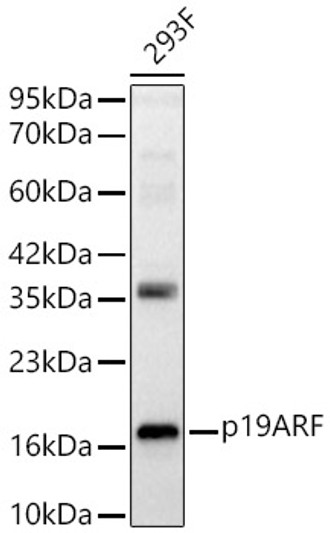| Post Translational Modifications | Ubiquitinated in normal cells by TRIP12 via the ubiquitin fusion degradation (UFD) pathway, a process that mediates ubiquitination at the N-terminus, regardless of the absence of lysine residues. Ubiquitination leads to its proteasomal degradation. In cancer cells, however, TRIP12 is located in a different cell compartment, preventing ubiquitination and degradation. |
| Function | Capable of inducing cell cycle arrest in G1 and G2 phases. Acts as a tumor suppressor. Binds to MDM2 and blocks its nucleocytoplasmic shuttling by sequestering it in the nucleolus. This inhibits the oncogenic action of MDM2 by blocking MDM2-induced degradation of p53 and enhancing p53-dependent transactivation and apoptosis. Also induces G2 arrest and apoptosis in a p53-independent manner by preventing the activation of cyclin B1/CDC2 complexes. Binds to BCL6 and down-regulates BCL6-induced transcriptional repression. Binds to E2F1 and MYC and blocks their transcriptional activator activity but has no effect on MYC transcriptional repression. Binds to TOP1/TOPOI and stimulates its activity. This complex binds to rRNA gene promoters and may play a role in rRNA transcription and/or maturation. Interacts with NPM1/B23 and promotes its polyubiquitination and degradation, thus inhibiting rRNA processing. Plays a role in inhibiting ribosome biogenesis, perhaps by binding to the nucleolar localization sequence of transcription termination factor TTF1, and thereby preventing nucleolar localization of TTF1. Interacts with COMMD1 and promotes its 'Lys63'-linked polyubiquitination. Interacts with UBE2I/UBC9 and enhances sumoylation of a number of its binding partners including MDM2 and E2F1. Binds to HUWE1 and represses its ubiquitin ligase activity. May play a role in controlling cell proliferation and apoptosis during mammary gland development. Isoform smARF: May be involved in regulation of autophagy and caspase-independent cell death.the short-lived mitochondrial isoform is stabilized by C1QBP. |
| Protein Name | Tumor Suppressor ArfAlternative Reading FrameArfCyclin-Dependent Kinase Inhibitor 2aP19arf |
| Cellular Localisation | NucleusNucleolusNucleoplasmIsoform Smarf: Mitochondrion |
| Alternative Antibody Names | Anti-Tumor Suppressor Arf antibodyAnti-Alternative Reading Frame antibodyAnti-Arf antibodyAnti-Cyclin-Dependent Kinase Inhibitor 2a antibodyAnti-P19arf antibodyAnti-Cdkn2a antibody |
Information sourced from Uniprot.org




